For this edition of Classic Steel we are going to take a look back at Honda’s 250 Enduro entry for 1986, the all-new XR250R.
For this edition of Classic Steel we are going to take a look back at Honda’s 250 Enduro entry for 1986, the all-new XR250R.
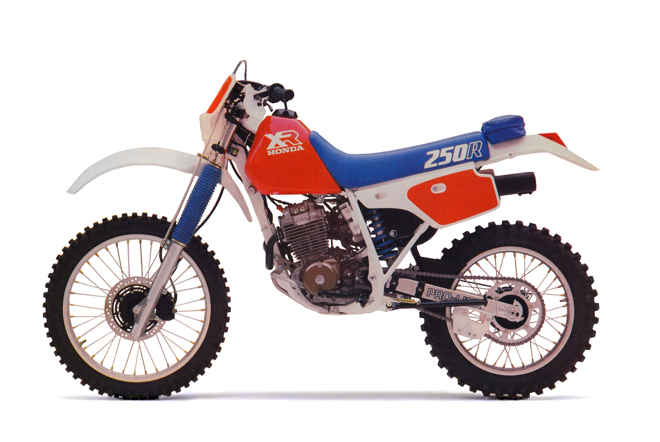 |
|
For years the red-headed stepchild in the XR line, the 250 finally got a serious upgrade in 1986. Photo Credit: Honda |
Today, Honda is a four-stroke company. They produce four-cycle powered lawn mowers, watercraft, weed eaters, generators, ATVs, cars, and of course, motorcycles. There is not an oil-burner to be found in their product portfolio. They were the last of the Big Four to produce a two-stroke and first of the Big Four to completely abandon them.
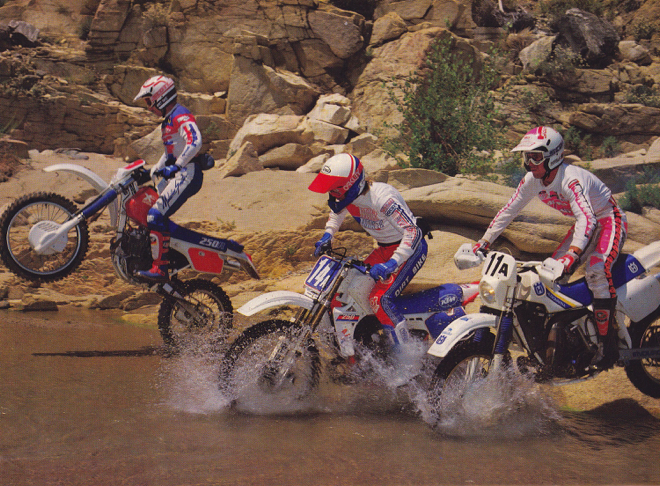 |
|
In 1986, the serious Enduro world was dominated by the Europeans. Japanese bikes like the XR250R, IT200 and KDX200 could certainly be raced, but their mission was less about trophies and more about fun. Photo Credit: Dirt Bike |
For Honda, the four-stroke motor is baked into their DNA. Even when the two-stroke was king, Big Red steadfastly stuck to producing valve-and–cam racers. The first of these was Honda’s revolutionary XR75. Introduced for the 1973 season, the little silver thumper went head-to-head against the two-strokes of its day and introduced a generation of young racers to the joys of Honda ownership.
 |
|
Billed by Honda as a “serious” middleweight Enduro contender, the original XR250 was little more than an XR500 with half the power and all the weight. Photo Credit: Honda |
In 1979, Honda added two more XRs to the mix with the introduction of the original XR250 and XR500. Using air-cooled OHC four-valve singles, the 250 and 500 were billed as legitimate alternatives to the lightweight two-strokes of their day. Honda literature proclaimed, “Now you can leave the competition two-strokes behind.” Although the 500 made a decent desert mount, the 250 was too slow, heavy and underperforming to be much of a woods weapon. Saddled with the weight of a 500, the power of a 200, and a peculiar 23-inch front wheel, the XR250 was a fun play bike, but not much of a racer.
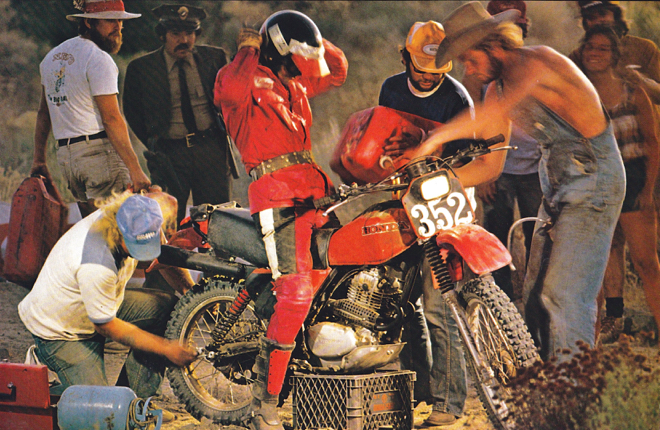 |
|
The brave souls who actually attempted to race the original XR250 quickly learned the limitations of its prodigious weight, funky “Claw Action” tires and floppy 23-inch front wheel. Photo Credit: Honda |
For 1981, Honda gave the XR250 its first major upgrade by ditching the dual shocks of the original and replacing them with a version of the works-style “Pro-Link” single-shock arrangements found on their factory motocross racers. In addition to the fancy shock, the XR250 received new sleeker bodywork and a change in front wheel size from the bizzaro 23-inch to a more conventional 21-inch. While this was a welcome change, the peculiar decision to move away from the industry-standard 18-inch rear to an oddball 17-inch rear left many riders scratching their heads.
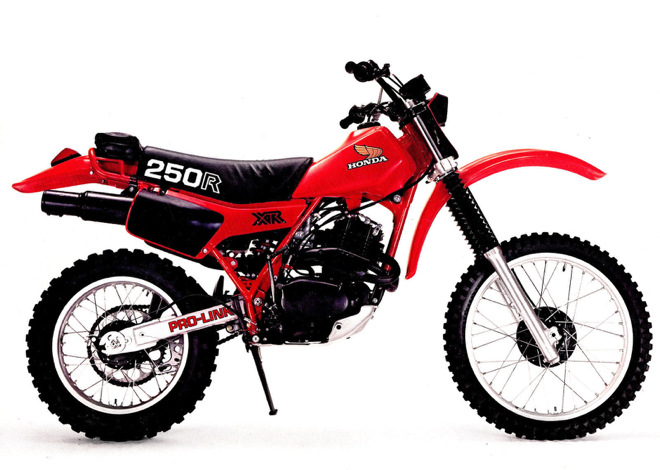 |
|
In 1981, Honda added the Pro-Link rear to the XR250R (The extra “R” was for Rotund), but did nothing about its nearly 300-pound girth and mild-mannered motor. |
In the motor department, the new XR250R (Honda deemed the Pro-Link XRs worthy of the “R” designation in 1981) retained the air-cooling and single-overhead-cam Pentroof design of the original. With its 249cc and four valves per cylinder, the XR was torquey, but not very fast. In today’s cross-country racing that would have been a death sentence, but in the off-road world of 1981, that was less of a handicap.
 |
|
Early XR250s made far better play bikes than serious racers. Photo Credit: Dirt Bike |
In 1981, Enduro was still king, and in that arena, the easy-to-ride XRs could be a viable mount (at least in the amateur classes). Unlike modern GNCC racing, which is basically a motocross through the woods, Enduro racing was as much about consistency as outright speed. Staying on time was the key, and a smooth and tractable bike made that job easier. The XR250R was no powerhouse, but it was pleasant and easy to handle. If the race was really tight and snotty, the XR actually had a shot at keeping the two-strokes in sight. If the course was more wide open, however, the smokers were going to leave the poor thumper in their dust.
 |
|
In 1983, Honda made a huge jump forward with the XR line. The all-new XR350R and totally redesigned XR500R featured high-tech motors, beefy suspension and sano looks. |
For 1983, Honda tried to address the power deficiencies of their XR line by introducing an all-new motor design. Making its debut on the XR350R and XR500R, the new engine used a hemispherical combustion chamber, narrow-angle valves and a centrally-located plug to provide a faster and more efficient burn than the old Pentroof design. Coined “RFVC” (Radial Four-Valve Combustion) by Honda, the new head allowed a higher compression ratio and more valve area to promote a better flow of fuel in and out of the combustion chamber.
 |
|
In 1983, Honda introduced a new engine design that they coined the “RFVC” (Radial Four Valve Combustion). Debuting on the XR350R and XR500R, the RFVC head featured a hemispherical combustion chamber, four narrow-angle valves and a centrally-located spark plug. The advantages of the RFVC over the old Pentroof design were its higher compression ratio, greater valve area and more efficient burn characteristics. |
In addition to the new heads, the new RFVC motors used an advanced dual-port intake that allowed a smoother and longer flow of power. Using a pair of piston-valve carbs (26mm on the XR350R and 28mm on the XR500R), the new XRs fed fuel to the motor from one of two intake runners based on throttle position. From idle to half-throttle, the engine drew fuel from one carb, for a smoother and more precise response. Past half throttle, the second intake circuit opened and the motor drew fuel from both carburetors to boost top-end power.
 |
|
Dual carbs made their debut with the new ’83 RFVC XRs. Working in stages, the two mixers were designed to provide a wider powerband. While innovative, the dual intakes made tuning the new XRs much more difficult than before. |
While the new XR350R and XR500R were stealing the headlines in 1983, the XR250R went on a yearlong hiatus. For 1984, it was back with an all-new motor, chassis and suspension. The new bike ditched its XR500 roots and instead took its lead from the smaller and more nimble XR200R. Powering the new bike was a scaled-down version of the RFVC mill used in the XR350R. It featured the same four-valve head, air-cooled layout and dual-carb intake. The new suspension punched up the travel to 10-inches front and 9.6-inches rear, while a sano front disc brake made stopping a breeze.
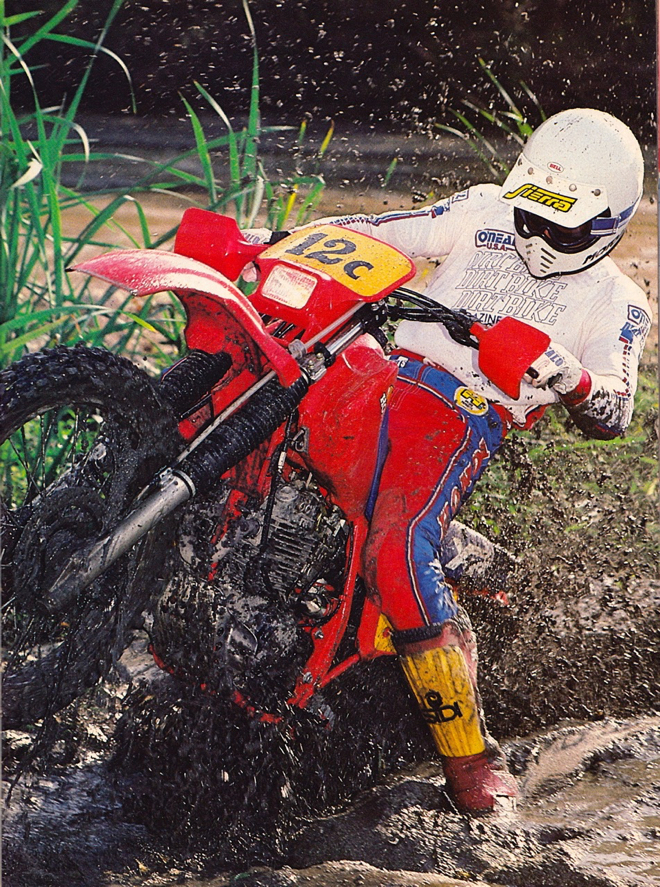 |
|
In 1984, Honda gave the XR250R a major redesign that upped the power and shaved the weight. This time, based on the XR200R instead of the XR500R, the new bike was far smaller, lighter and more nimble than before. Photo Credit: Dirt Bike |
 |
|
Although much improved over previous XR250Rs, the 1984-1985 versions were not without fault. Chief among these deficiencies were its overly soft valve springs and propensity for running extremely hot. If run hard, these XRs tended to cook their oil and float their valves with predictably horrible consequences. |
At a dry weight of 247 pounds, the new XR250R was a whopping 34 pounds lighter than the ’82 250. The new chassis was much more compact and overall comfort was better than ever. The new RFVC motor was pleasant and revved higher than ever before, but power was not in overabundance. The new dual carbs also made jetting the bike a real hassle and if they ever got out of sync, you were in for a world of frustration. The new motor retained the wet sump design of the old mill and shared its habit of running very hot. The quirky 17-inch rear rim also remained, a feature Honda claimed lowered the seat height (at the expense of rubber selection). Even with the additional travel of the new suspension, the XR was much happier at puttering over roots than pounding through whoops. Overall, it was a huge improvement, but still no thoroughbred.
 |
|
In 1985, Honda once again upped their four-stroke game with an all-new XR600R and totally redesigned XR350R. Both bikes featured major improvements that upgraded their competitiveness. |
For 1985, Honda got serious about their four-strokes with a major update to their middleweight XR350R and big-bore XR600R. The new XR350R ditched the dual-carb setup and oil-roasting wet-sump lubrication system of ‘84 and replaced it with a simpler single 35mm carb and cooler dry-sump configuration. The new motor retained the RFVC head design, but boosted torque with a longer stroke and increased displacement. The rest of the bike was just as new as the motor and the chassis, suspension and ergonomics were all greatly improved for 1985.
 |
|
In 1985, Honda finally got the four-stroke formula right with the excellent XR350R. Photo Credit: Dirt Bike |
The new 353cc (up from 339cc in 1984) motor came on stronger down low and pulled harder over a broader range than 1984, but it was still soft compared to a two-stroke of similar displacement (or even a 250 for that matter). The bike had excellent torque and a wide powerband, but not a lot of thrust past the midrange. The suspension was still too soft for any high-speed work and at 263 pounds, it was no lightweight. Overall, the new 350 was by far the most competitive XR to date, but still not in the same league as best Enduro bikes from Europe.
 |
|
For 1986, Honda discontinued the XR350R and threw all of their off-road R & D budget at the XR250R. New from the ground up, the ’86 250 was by far the most competitive XR250 to date. Photo Credit: Honda |
For 1986, Honda took much of what they learned with the successful ’85 redesign of the XR350R and poured it into the XR250R. First up was an all-new motor that aimed to beef up the torque on the rev-happy 250. Learning from what had worked the year before, Honda decreased the bore and increased the stroke on the 249cc mill. Overall displacement remained the same, but now it was an oversquare 73 x 59.5mm. The new motor retained the air-cooling of the old design, but added an external oil cooler and second rotor for the oil pump to combat its habit of roasting the oil. The overall oil capacity was also bumped up, but the 250 did not get the external oil tank of the ’85 350.
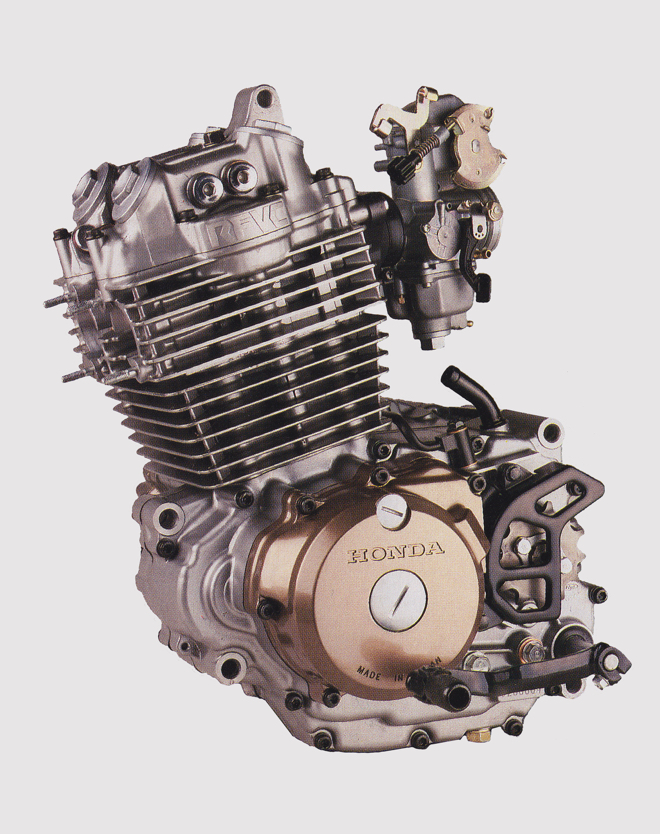 |
|
The 1986 XR250R featured a redesigned motor that boosted torque and increased overall power. The new RFVC motor retained the 249cc displacement of the old mill, but featured a smaller bore and longer stroke. The new motor also ditched the finicky dual-carb setup of ’84-’85 and replaced it with a single 30mm Keihin mixer. Photo Credit: Honda |
The new 250 retained the basic RFVC head design Honda had used on its XRs since 1983 and mated it to an all-new dual-pipe exhaust. On the intake side, the ’86 250 also followed the 350’s lead by doing away with the persnickety dual carbs and going to a single 30mm Keihin. Inside the motor, the six-speed transmission, gear-driven counter balancer and clutch were all carryovers.
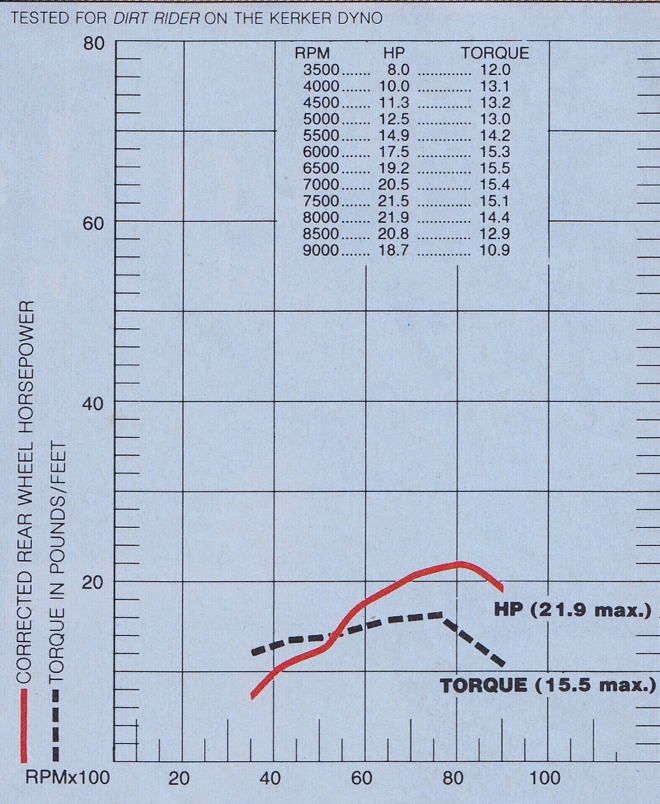 |
|
While not a powerhouse, the ’86 XR motor was smooth, torquey and easy to ride. The low-end torque was much improved over previous XR250s, but peak power still lagged well behind two-strokes of similar displacement. Photo Credit: Dirt Rider |
In the chassis department, Honda looked to address the major complaints people had voiced about the outgoing design. Chief amongst these were its lack of stability and flimsy suspension. In the trees the XR was a surgeon, but open things up, and the bike’s twitchy geometry and wimpy suspension made riding a white-knuckle experience.
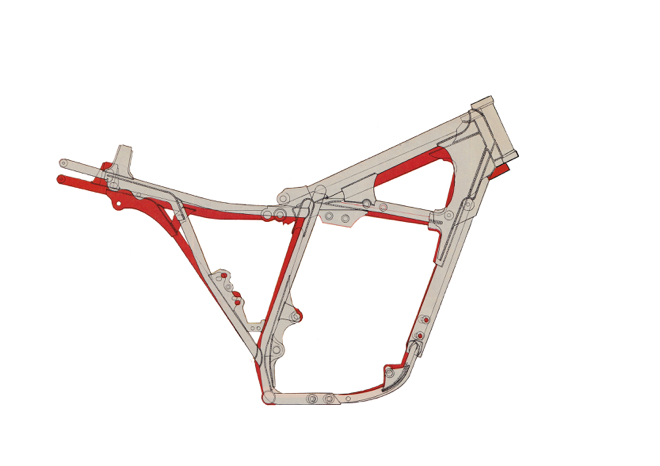 |
|
The all-new chassis (the 1986 frame is shown in white, superimposed over the red 1985 XR250R frame) on the 1986 XR250R stretched out the rider compartment and extended the wheelbase a full 3.5 inches over 1985. |
In order to remedy this, Honda both redesigned the frame and beefed up the suspension components for 1986. First up was a round-filing of the old 38mm forks in favor of a set of beefy 41mm Kayaba units. These components were similar to the ones found on the CR125R, but 2mm smaller in size. A new Pro-Link rear suspension was also bolted on that ditched the heavy steel swingarm of ’85 in favor of a trick alloy unit. Overall travel was also bumped up from 9.6-inches to a full 11-inches of travel for ’86.
 |
|
The new motor maintained the wet-sump lubrication system and air-cooling of the old design, but featured several improvements to help keep the new XR from roasting its vital fluids. Along with an increase in oil capacity, engineers added a second rotor to the oil pump and a small oil cooler to help keep temps under control. Photo Credit: Honda |
 |
|
New tubular aluminum engine guards replaced the full skid plate of 1985. They were lighter and less prone to collecting mud, but less protective. |
On the frame side, Honda stretched out the riding compartment by moving the steering head forward an inch-and-a-half and lengthening the overall wheelbase a full 3.5 inches. Overall steering geometry remained very similar, with a 0.5 degree increase in trail over ’85. The new chromoly steel frame was also much stronger for 1986, with a large box-section downtube and additional bracing throughout.
 |
|
New 41mm Kayaba forks (up from 38mm in 1985) on the ’86 XR cut down the flex, but did nothing for the bike’s overly soft reputation. Rocks and roots were taken in stride, but whoops and jumps overwhelmed its marshmallow-soft springs and inadequate damping. Photo Credit: Honda |
On the trail, the XR250R was a much-improved machine for 1986. The redesigned bodywork and new saddle allowed much easier movement fore-to-aft and the bike was far slimmer through the middle and up the tank. The new chassis was excellent at slithering through the trees and much less spooky at speed. The bike was still a handful in deep sand, but that had as much to do with the bike’s mushy suspension as the frame’s geometry. The new forks offered much less flex, but they were still too soft for anything other than tight woods work. There were 21 adjustable compression settings and Schrader valves that allowed for air to be added, but without stiffer springs and a re-valve, they were going to continue to be more adept at roots than whoops.
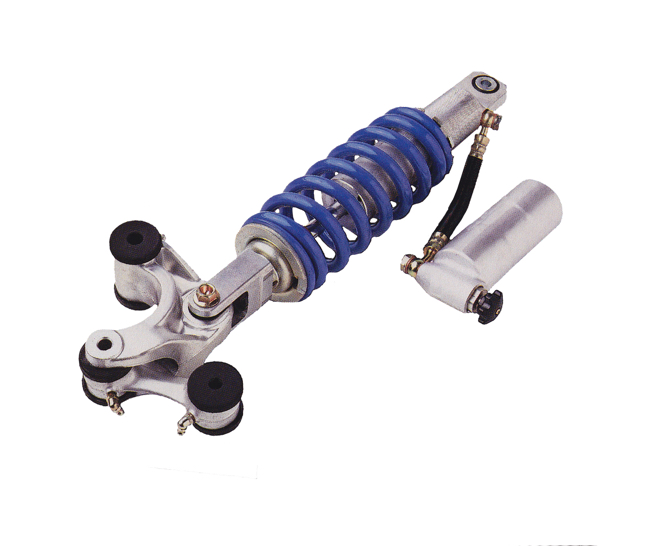 |
|
In 1986, Honda totally revamped the Pro-Link rear suspension on the XR250R. An all-new new Kayaba damper offered more travel and a wide range of adjustments, but the same old performance. Like the forks, it was better at rock hopping than double-jumping. Photo Credit: Honda |
Out back, the new shock was similarly too soft for anything approaching race speed. There were 16 available compression settings and 4 rebound adjustments, but even with these cranked all the way in, the shock was a busy, hopping mess. On hard hits, it slammed to the stops, then shot straight back up at the rider’s fanny pack like a nitrogen-charged pogo stick. In deep sand whoops, the XR was a massive handful and it was best to back off, rather than risk being ejected into a yucca bush.
 |
|
Earthquake warning: Antics like the one being executed here by Dirt Bike’s resident loon Steve Schmitz were possible, but inadvisable. Any leaps higher than your average milk crate were likely to greet you with a metal-to-metal clank at both ends. Photo Credit: Dirt Bike |
On the motor front, the new XR was torquier than ever, but still no stump puller. As with previous 250s, the best method was to keep it pinned and row the excellent six-speed gearbox. There was good low-end and a solid midrange, but not a ton of top-end thrust. At peak, it gave up a full 3 horsepower to Kawasaki’s KDX200, no rocket in its own right. Compared to previous XR250s it was a big improvement, but line it up next to a 250 two-stroke and you better hope they were going to foul a plug.
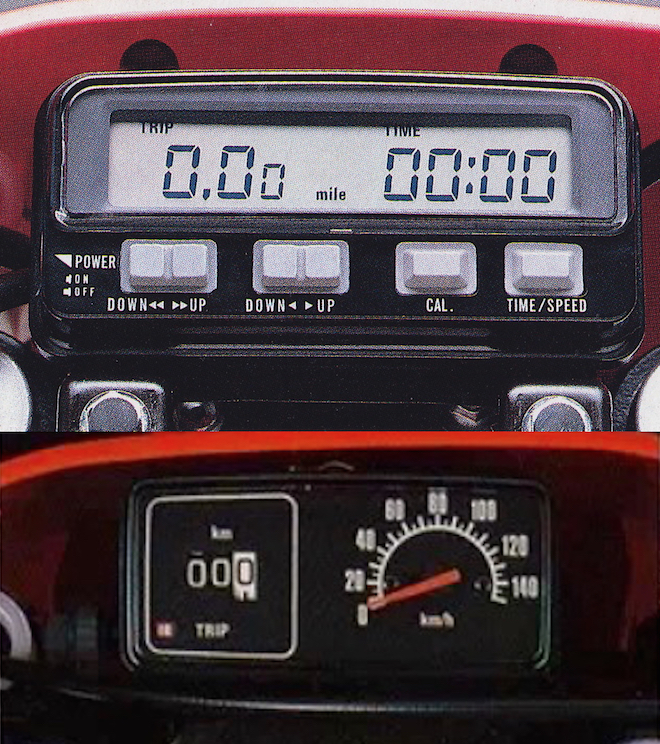 |
|
While most of the ’86 XR250R was improved over previous models, the new bike did not get the ultra-cool Enduro computer found on the larger XR600R (top) and had to make due with a much simpler speedo/odo combo (bottom). |
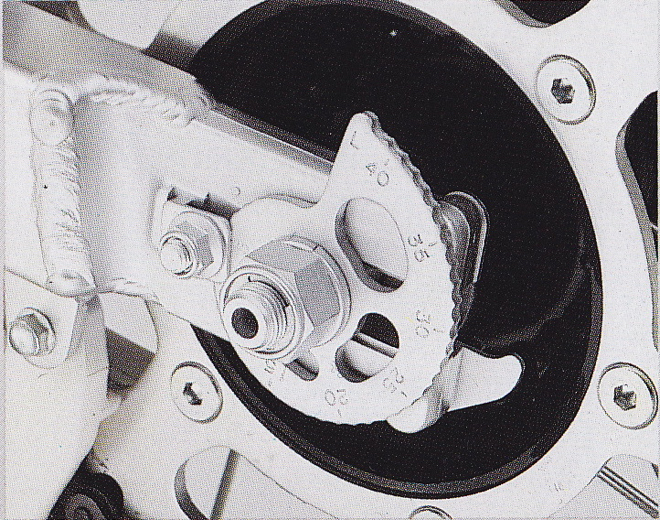 |
|
An new quick-release rear axle with built in snail-adjusters aided trailside maintenance in 1986. |
On the detailing front, the XR was mostly excellent, with a few disappointments. The new tubular alloy crash bars for the motor cut weight, improved cooling and looked trick, but offered a bit less protection than the massive skid plate of ’85. The new oil cooler lowered engine temps (a full 27 degrees centigrade according to Honda), but without the benefit of an external oil tank, the bike continued to run very hot when pushed. Starting was also hit-or-miss, with the bike taking between one-to-a-dozen kicks when cold, and five-to-five-thousand when hot. The new quick-detach rear wheel was certainly a plus and the switch back to an 18-inch rear wheel made tire choices much easier. Braking was a mixed bag, with an excellent Nissin dual-piston binder up front and a pathetic and fade-prone drum in the rear.
 |
|
With some minor mods, the XR250R became a much more competitive Enduro mount. Ditching the stock boat-anchor muffler, opening up the airbox and re-jetting the carb yielded impressive power gains, while a step up in spring rate front and rear made the bike more capable out of the woods. Photo Credit: Dirt Bike |
Overall, the new XR250R was a big step forward for Honda’s XR program. It was far more capable than any XR250 ever offered and a solid trail mount and play-racer. For hard core racing it was too slow and too soft, but if the conditions were gnarly enough, it could at least keep the smokers in sight. It made a great play bike and a decent eastern Enduro weapon. Most of all, it was reliable, fun and capable of taking on any adventure you were inclined to tackle. In the end, isn’t than what off-road riding is all about?
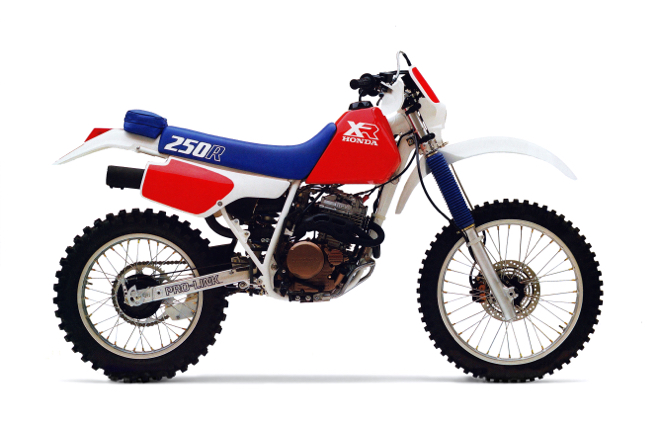 |
|
In 1986, Honda pumped up the power, fine-tuned the handling, and smoothed out the ergonomics on their quarter-liter Enduro racer. While certainly no two-stroke killer, the new XR250R was capable, reliable and just plain fun. Photo Credit: Honda |
For your daily dose of old-school moto goodness, make sure to follow me on Twitter and Instagram -@TonyBlazier
For questions or comments, feel free to drop me a line anytime at TheMotocrossVault@Gmail.com





